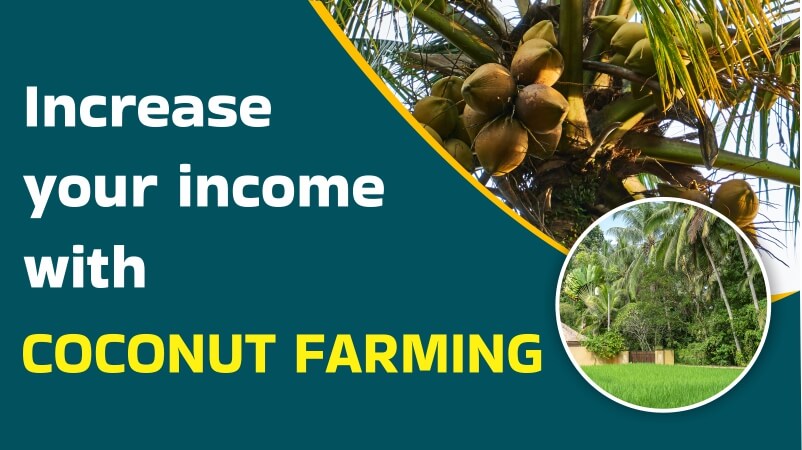Introduction About Coconut Farming:
The tropical fruit plant known as the coconut is widely cultivated in a variety of tropical and subtropical nations. Despite contrary evidence, it is thought that Malaysia is in South Asia. The entire coastal strip of India is planted with coconut palms. Kerala, Karnataka, and Tamil Nadu receive the lion’s share of the market, followed by Goa, Maharashtra, Andhra Pradesh, and Orissa.
Every component of the coconut palm is valuable to humanity. It provides us with shelter, food, drink, fuel, and oil. There are various uses for the wet kernel, desiccated copra, coconut water, cream flour, oil, cake, toddy, husk, fiber, shell, coir, wood, and leaves.
Profitable Business Idea:
Coconuts can germinate, grow into coconut palms, and begin fruiting after three years in an area with the right climate, rainfall, and other environmental factors. Coconut is sold all over India, from north to south. It has a wide range of applications, from religious rituals to medications and cosmetics. A coconut palm tree can bear fruit for up to 80 years. As a result, cultivating it has many advantages.
Given that it grows to a height of more than 10 meters, the coconut plant is also known as “Kalpavriksha” or “the plant of heaven.” India is the country that produces the most coconuts worldwide. The cultivation of coconuts requires little work, and you can make thousands of dollars with very little capital. Pesticides and pricey fertilizers are not needed for its growth. Whiteflies, however, can harm coconut plants. Farmers must therefore take this into consideration.
Uses of Coconut:
Coconut farmers are enthusiastic about growing coconuts due to the ever-increasing demand for coconuts in both the local and global markets. One of the few crops that allow for a reasonable return, it is believed that at least 1.2 crore people earn a living from coconuts or coconut products each year, including growers as well as traders, pickers, and laborers.
Coconut and/or its byproducts are significant for a variety of companies, including those in the food, pharmaceutical, farming, and gardening sectors. The coconut tree itself is utilized for construction and as fuel, while the leaves are used for roofing. Ropes, mats, brushes, mattresses, and other items are made from the husk. In addition to being used to make plywood, the shell is also used to make mosquito coils and incense sticks. In their natural state, coconut flour, coconut milk, and coconut oil are eaten as food. In several regions of the country, the tree’s sap is used to manufacture sugar, jaggery, and a traditional beverage.
Coconut Productivity:
Coconut production varies depending on the kind and location. Low yield varieties that are typically used for copra and oil production could perform worse than high yield varieties that are mostly grown for coconut water. Both plants will yield about the same profit if you use monetary values. When it comes to producing sensitive coconuts, soil conditions and water availability are crucial factors. The trees must receive sufficient water throughout the year; failing to do so will result in high costs. Traditional types require far less maintenance and require much less water. This does not imply that you should neglect to water your trees.
Site Selection for Coconut Farming:
It’s necessary to plan before planting coconut trees, especially in a large-scale farming scheme. Planning every step of the process can help you manage your coconut trees more effectively, reduce errors, and enhance yield. Your choice of the site should be your first consideration. The site’s suitability will have the most impact. It will be the element that determines whether you succeed or fail, how much effort you put in, and how much you will receive in return.
A suitable location will be free of water stagnation, will have easy access to water sources in dry times, will be simple to transport coconuts once picking is complete, and will also be simple for laborers to complete the essential duties, such as pest control and manuring. Perfect soil should also be taken into account. It is preferable to stay away from the plot if the spot you choose has clay soil and if water retention is excessive. If the land you choose is on a slope, you should think about how to efficiently retain soil and prevent nutrient runoff. The ideal location for a coconut plantation is sandy soil, year-round water availability, and water supplies. Most of the time, the rest is manageable.
Preparation of Soil, Land, and Planting:
The next stage is to prepare the entire space after choosing the place. Flatten the area as much as you can. At work, you might require a bulldozer or a leveler/flattener. For optimal results, make the entire area clear. Trees should be cut down because they will compete with the new coconut saplings for nutrients and sunshine. Remove any and all weeds and shrubs.
The nutrient-rich topsoil frequently becomes unusable during land flattening and plowing and goes downward. Before planting your coconut tree saplings, you must make repairs to the slight nutrient shortage this causes.
Season and the Best Time for Coconut Plantation:
The first few years of your coconut palm’s growth are heavily influenced by the weather. Coconut needs some water as well, but not a lot in the first few years. It is not advisable to submerge the saplings in water. As a result, High monsoon regions should plant coconuts as soon as the monsoon is over. In Kerala, the best months are August and September. Plantation happens just before the monsoon in regions with little rain.
To learn more about tractors, tractor prices, and tractor videos, go to khetigaadi.com. Also, for farming-related questions, check out the khetiguru mobile application.



